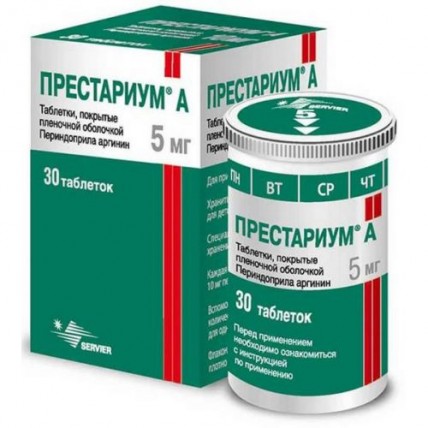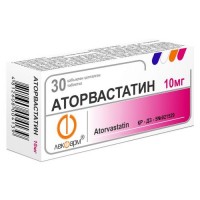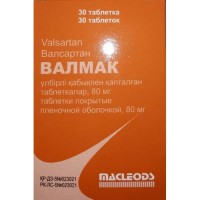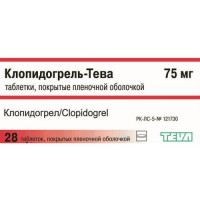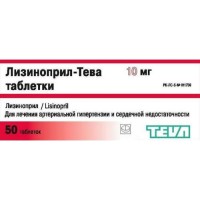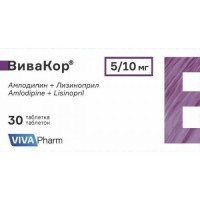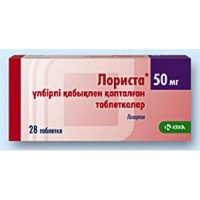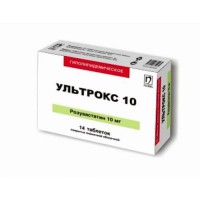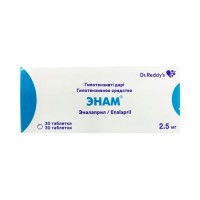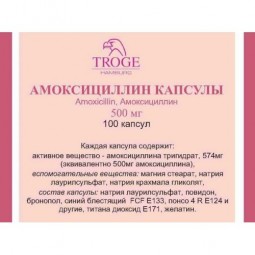Prestarium 30s 5 mg film-coated tablets
- $26.30
Out Of Stock
The instruction for medical use of Prestarium 5 medicine of mg the Trade name of Prestarium 5 mg the International unlicensed name Perindopril Lekarstvennaya the Tablet form, film coated 5 mg Structure One tablet contains active agent - perindoprit arginine of 5 mg respectively (it is equivalent to the maintenance of a perindopril of 3.395 mg), excipients: lactoses monohydrate, magnesium stearate, maltodextrin, silicon dioxide colloidal anhydrous, sodium of starch glikolit (type A) a cover: ** mix for a covering of light green color, a macrogoal 6000, ** Sepifilm 4193 (glycerin, a gipromelloza, copper chlorophyllin (E141ii), a macrogoal 6000, magnesium stearate, the titan dioxide (E171), *** Sepifilm NT 3407 (glycerin, a gipromelloza, copper chlorophyllin (E141ii), a macrogoal 6000, magnesium stearate, the titan dioxide (E171) the Description of Prestarium 5 mg: oblong tablets, film coated light green color, rounded off from two parties, with notches from two sides and an engraving in the form of a logo of firm on one of the faces Pharmacotherapeutic group the Cardiovascular system. The drugs influencing renin-angiotenzinovuyu a system. Enzyme Angiotensin-converting (EAC) inhibitors, simple. Perindopril the ATX C09AA04 Code intake perindoprit the Pharmacological Pharmacokinetics Absorption At properties quickly is soaked up in digestive tract, the maximum concentration (Cmax) in blood plasma is reached in 1 h. Elimination half-life (T1/2) of a perindopril makes 1 h of blood plasma Perindopril has no pharmacological activity. About 27% of total number of the absorbed perindopril get to a blood stream in the form of an active metabolite of the perindoprilat. Besides the perindoprilat, 5 more metabolites which do not have pharmacological activity are formed. Perindoprilat Cmax in blood plasma is reached in 3-4 h after intake. Meal slows down transformation of a perindopril in perindoprilat, thus, affecting bioavailability. Therefore the drug should be taken in 1 times a day, in the morning, before meal. It was shown that the dependence between a dose of a perindopril and concentration it in plasma has linear character. Distribution the Volume of distribution of the free perindoprilat makes about 0.2 l/kg. Communication of the perindoprilat with proteins of blood plasma, mainly with AKF, makes 20%, and has dose-dependent character. Removal Perindoprilat is brought out of an organism by kidneys, and final elimination half-life of free fraction makes about 17 hours, as a result the equilibrium state is reached within 4 days. Special groups of patients Removal of the perindoprilat is slowed down at advanced age and also at patients with a heart and renal failure. The dialysis clearance of the perindoprilat is 70 ml/min. At patients with cirrhosis the hepatic clearance of a perindopril decreases twice. Nevertheless, the number of the formed perindoprilat does not decrease, and dose adjustment of drug is not required. A pharmacodynamics the action Mechanism Perindopril – inhibitor the angiotensin-the converting enzyme (ACE) turning angiotensin I into angiotensin II. AKF, or a kininaza of II, is ekzopeptidazy which carries out as transformation of angiotensin I into vasoconstrictive substance angiotensin II, and destruction of the bradykinin possessing vasodilating action to inactive heptapeptide. The inhibition of AKF leads to decrease in concentration of angiotensin II in blood plasma that causes increase in activity of renin of blood plasma (on the mechanism of negative feedback) and reduction of secretion of Aldosteronum. As angiotensin - the converting enzyme inactivates bradykinin, suppression of AKF is followed by increase in the activity as circulating, and a fabric kallikrein-kinin system, at the same time the system of prostaglandins is also activated. It is possible that this effect is a part of the mechanism of antihypertensive effect of AKF inhibitors and also the mechanism of development of some side effects of drugs of this class (for example, cough). Perindopril has therapeutic effect thanks to an active metabolite to a perindoprilat. Other metabolites have no inhibiting effect concerning AKF in vitro. Clinical performance and safety Arterial hypertension Perindopril is effective in therapy of arterial hypertension of any severity. Against the background of use of drug the decrease in both the systolic, and diastolic arterial blood pressure (ABP) in position of the patient is noted lying and standing. Perindopril reduces the general peripheric vascular resistance (GPVR) that leads to decrease in the ABP, at the same time the peripheral blood stream accelerates without change of the heart rate (HR). As a rule, perindoprit leads to increase in a renal blood-groove, glomerular filtration rate at the same time does not change. Antihypertensive effect of drug reaches a maximum in 4-6 hours after single dose inside and remains during 24 h. In 24 hours after intake the residual inhibition of AKF is observed expressed (about 87 - 100%). Decrease in the ABP is reached quickly enough. At patients with the positive response to treatment the normalization of the ABP occurs within a month and remains without development of a tachyphylaxis. The termination of treatment is not followed by development of effect of ricochet. Perindopril has vasodilating effect, promotes recovery of elasticity of large arteries and structures of a vascular wall of small arteries and also reduces a hypertrophy of a left ventricle. Co-administration of thiazide diuretics enhances expressiveness of antihypertensive effect. Besides, combination of AKF inhibitor and thiazide diuretic also leads to reduction of risk of development of a hypopotassemia against the background of intake of diuretics. Heart failure: Perindopril normalizes cardiac performance, reducing preloading and an afterload. At the patients with chronic heart failure receiving perindoprit, it was revealed: - pressure decrease of filling in the left and right ventricles of heart, - decrease in the general peripheric resistance of vessels, - increase in warm emission and increase in cardiac index. Patients of children's age (up to 18 years): The efficiency and safety of use of a perindopril for children and teenagers aged up to 18 years is not established. Indications - arterial hypertension - chronic heart failure - a stable ischemic heart disease: reduction of risk of cardiovascular complications at patients from a stable ischemic heart disease. The route of administration and doses is recommended to take the Drug in the morning, 1 time a day, before food. At treatment of arterial hypertension of Prestarium 5 mg it can be used as monotherapy or in a combination with hypotensive drugs of other groups. The recommended initial dose – 5 mg once a day (morning), if necessary a dose can be gradually increased up to 2 tablets (10 mg) a day. At the significant activation of the renin-angiotensin-Aldosteronum system (in particular, at patients with renovascular hypertensia, electrolytic disturbances and/or with a reduced the volume of the circulating blood (VCB), a decompensation of warm activity or heavy hypertensia) after reception of an initial dose there can occur sharp falling of arterial blood pressure. Treatment of such patients is recommended to begin with a dose 2.5 mg under stringent control. After 1 month of therapy the dose can be raised to 10 mg once a day. Treatment of elderly patients with arterial hypertension it is necessary to begin 2.5 mg with a dosage, gradually increasing it: up to 5 mg in a month after an initiation of treatment, then – up to 10 mg, depending on a functional condition of kidneys (see the table below). At treatment of chronic heart failure the recommended dose – a half of a tablet (2.5 mg) in day. Use of drug about potassium needs to be begun with not preserving diuretics and/or digoxin and/or beta-blockers under fixed medical observation, the recommended initial dose makes 2.5 mg in the morning. At good tolerance the dose is increased step by step by 2.5 mg before achievement of a dose by 5 mg once a day with observance of an interval not less than 2 weeks. Clinical reaction of each specific patient has to be the basis for such correction. At treatment of coronary heart disease administration of drug it is necessary to begin with a dose 5 mg within 2 weeks once a day, then to increase to 10 mg once a day, depending on a condition of kidneys and on condition of good tolerance of a dose 5 mg. Patients of advanced age therapy should begin with a dose 2.5 mg within 1 week once a day, then, within 1 week – on 5 mg once a day, then – to increase a daily dose to 10 mg depending on function of kidneys (see the table below). The dose is raised only in case of good tolerance of lower previous dose. Dose adjustment in a renal failure the Dose for patients with a renal failure has to be selected depending on clearance of creatinine, according to the table which is given below: The clearance of creatinine (ClCr), ClCr dose Recommended to ml/min. ≥ 60 5 mg a day 30<, ClCr<, 60 2,5 mg a day 15<, ClCr<, 30 2,5 mg a day every other day the Patients who are on a hemodialysis * ClCr< of 15 2,5 mg in day of dialysis * Dialysis clearance of the perindoprilat is 70 ml/min. The patients passing a hemodialysis have to take the drug after dialysis. The liver failure is not required to Patients with an abnormal liver function of dose adjustment. Престариум® 5 of mg should not appoint age up to 18 years children and teenagers up to 18 years due to the lack of data on efficiency and safety of use of drug for patients of this age group. There are no sufficient data on safety and efficiency of use of a perindopril for children and teenagers aged up to 18 years now. Side effects the Profile of safety of a perindopril matches a profile of safety of AKF inhibitors: The most widespread undesirable effects revealed during clinical trials and noted with perindoprily: dizziness, headache, paresthesia, vertigo, disorders of vision, tinnitus, hypotension, cough, short wind, abdominal pain, constipation, diarrhea, dysgeusia, dyspepsia, nausea, vomiting, itching, rash, muscular spasms and asthenia. Frequency of side reactions which can arise during therapy is specified in a type of the following gradation: very often (& gt, 1/10), it is frequent (& gt, 1/100, & lt, 1/10), infrequently (& gt, 1/1000, & lt, 1/100), is rare (& gt, 1/10,000, & lt, 1/1000), is very rare (& lt, 1/10,000), frequency is not established (frequency cannot be counted according to available data). Often - cough, short wind - a headache, an asthenia, dizziness, muscular spasms, paresthesia, - a dysgeusia, disorders of vision, tinnitus, vertigo, hypotension (and effects, - connected with hypotension) - vomiting, nausea, an abdominal pain, a constipation, diarrhea, dyspepsia - an itching, rash Infrequently - an eosinophilia * - a hyponatremia * - the hyperpotassemia reversible at the treatment termination *, the increased urea content in blood *, the increased creatinine content in blood * - a hypoglycemia * - drowsiness * - a syncope *, an indisposition *, a stethalgia * - tachycardia * a cardiopalmus * - a vasculitis *, peripheral hypostasis *, a hyperthermia * - reactions of photosensitivity * - an arthralgia *, myalgia * - falling * - differences of mood - a sleep disorder - a bronchospasm - dryness in a mouth - a small tortoiseshell - pemphigoid, a hyperhidrosis - a renal failure - erectile dysfunction - a Quincke's disease of the face, extremities, lips, mucous membranes, language, a glottis and/or throat, is rare - the increased bilirubin content in blood, increase in level of enzymes in a liver - deterioration in psoriasis * Is very rare - arrhythmia, stenocardia, a myocardial infarction which is perhaps caused by very big hypotension in patients of group of high risk, the stroke which is perhaps caused by very big hypotension in patients of group of high risk - eosinophilic pneumonia, rhinitis - pancreatitis - hepatitis, cytolytic or cholestatic - an erythema mnogoformny - the lowered hemoglobin and a hematocrit, an agranulocytosis or a pancytopenia, a leukopenia/neutropenia, hemolytic anemia at patients with congenital insufficiency glyukozo-6-fosfatdegidrogenazy, thrombocytopenia - confusion of consciousness - an acute renal failure * Frequency is counted by results of clinical trials regarding the by-effects revealed from spontaneous messages. Cases of the Syndrome of Inadequate Secretion of Antidiuretic Hormone (SISAH) were reported with other AKF inhibitors. SNSAG can be considered as very rare, but possible complication connected with therapy by AKF inhibitor, including perindoprily. Contraindications - hypersensitivity to a perindopril and other compound components of drug or the AKF any other inhibitor - the Quincke's disease in the anamnesis connected with the previous treatment by AKF inhibitors - a hereditary/idiopathic Quincke's disease - the second and third trimester of pregnancy - the combined reception with Aliskiren the patients having diabetes or a renal failure (SKF & lt, 60 ml/min. / 1.73 m ²) - simultaneous use with sakubitrilom/valsartany - the extracorporal treatments leading to contact of blood with negatively charged surfaces - a significant bilateral renal artery stenosis or a stenosis of an artery in the only functioning kidney - persons with hereditary intolerance of fructose, deficiency of Lapp-lactases enzyme, glucose galactose malabsorption - children and teenagers up to 18 years (the efficiency and safety is not established). Medicinal interactions Double blockade leads the system renin-angiotensin-aldosteronovoy (SRAA) as a result of a concomitant use of AKF, MACAW inhibitors II or an aliskiren to increase in frequency of emergence of such undesirable phenomena as arterial hypotension, a hyperpotassemia and renal failures (including an acute renal failure), in comparison with situations when only one drug influencing RAAS is used. The medicines causing a hyperpotassemia Some medicines or drugs of other pharmacological classes can increase risk of development of a hyperpotassemia: aliskiren and aliskirensoderzhashchy drugs, potassium salts, kaliysberegayushchy diuretics, AKF inhibitors, antagonists of receptors of angiotensin II (MACAW of II), non-steroidal anti-inflammatory drugs (NPVP), heparin, immunodepressants, such as cyclosporine or takrolimus, Trimethoprimum. The combination of these medicines increases risk of a hyperpotassemia. Simultaneous use is contraindicated Aliskiren. At patients with diabetes or renal failures the risk of a hyperpotassemia, deterioration in function of kidneys and increase in frequency of cardiovascular incidence and mortality increases. Extracorporal treatments: The extracorporal treatments leading to contact of blood with negatively charged surfaces, such as dialysis or haemo filtration with certain membranes with high hydraulic permeability (for example, poliakrilnitrilny membranes) and aferez lipoproteins of low density a dextran sulfate in view of the increased risk of emergence of heavy anaphylactoid reactions. If such treatment is required, then it is necessary to take use of other type of a dialysis membrane or other class of hypotensive drug into account. Sakubitril/valsartan: Simultaneous use of a perindopril with sakubitrilom/valsartany is contraindicated as simultaneous inhibition of a neprilizin and AKF can increase risk of emergence of an angioedema. Reception of a sakubitrila/valsartan cannot be begun till 36 o'clock after reception of the last dose of therapy perindoprily. Therapy perindoprily cannot be begun till 36 o'clock after reception of the last dose of a sakubitrila/valsartan. Simultaneous use is not recommended Aliskiren. At the patients who do not have diabetes or a renal failure the increase in risk of a hyperpotassemia, deterioration in function of kidneys and increase in frequency of cardiovascular incidence and mortality is possible. Joint therapy by AKF inhibitors and antagonists of receptors of angiotensin In literature it was reported that at patients with the established atherosclerotic disease, heart failure or diabetes with damage of target organs, simultaneous therapy of AKF and MACAW inhibitor II is connected with higher frequency of development of arterial hypotension, faint, a hyperpotassemia and
hudsheniye of function of kidneys (including an acute renal failure) in comparison with use only of one drug influencing RAAS. Double blockade (for example, at an AKF inhibitor combination to the MACAW of II) has to be limited to separate cases with careful monitoring of function of kidneys, the content of potassium and the ABP. Estramustinum: Simultaneous use can lead to increase in risk of side effects, such as Quincke's disease. Co-trimoxazole (Trimethoprimum / sulfamethoxazole): The patients who are at the same time accepting co-trimoxazole (Trimethoprimum/sulfamethoxazole) can be exposed to also increased risk of a hyperpotassemia. Kaliysberegayushchy diuretics (such as Triamterenum, amiloride), potassium salts the Hyperpotassemia (with a possible lethal outcome), especially in a renal failure (the additional effects connected with a hyperpotassemia). The combination of a perindopril to above-mentioned medicines is not recommended. If, nevertheless, simultaneous use is shown, they should be applied, observing precautionary measures and regularly controlling potassium content in blood serum. Features of use of Spironolactonum in heart failure are described further in the text. Lithium drugs At simultaneous use of drugs of lithium and AKF inhibitors the reversible increase in concentration of lithium in blood serum and the toxic effects connected with it can be noted. Simultaneous use of a perindopril and drugs of lithium is not recommended. In need of performing such therapy it is necessary to carry out regular control of concentration of lithium in blood plasma. Nonsteroid anti-inflammatory medications (NPVS), including aspirin ³ 3 g/day. NPVP, including high doses of acetylsalicylic acid (≥ 3 g/days) Simultaneous use of AKF inhibitors with NPVP (acetylsalicylic acid in the dose having anti-inflammatory effect, inhibitors of cyclooxygenase-2 (TsOG-2) and non-selective NPVP), can lead to decrease in antihypertensive effect of AKF inhibitors. Simultaneous use of AKF and NPVP inhibitors can lead to deterioration in function of kidneys, including development of an acute renal failure, and to increase in content of potassium in blood serum, especially at patients with reduced function of kidneys. It is necessary to be careful when assigning this combination, especially at elderly patients. Patients have to receive adequate amount of liquid, and it is recommended to control carefully function of kidneys, both at the beginning, and in the course of treatment. Baclofenum Enhances antihypertensive effect of AKF inhibitors. It is necessary to control carefully the ABP level and, in case of need, a dosage of hypotensive drugs. Kaliynesberegayushchy diuretics (all other diuretics) At the patients receiving the diuretics which are especially removing liquid and/or salts at the beginning of therapy perindoprily the excessive decrease in the ABP which risk of development can be reduced by cancellation of diuretic means, completion of loss of liquid or salts before therapy perindoprily and also purpose of a perindopril in a low dose with its further gradual increase can be observed. In arterial hypertension the patients receiving the diuretics which are especially removing liquid and/or salts, have to have diuretics or are cancelled prior to AKF inhibitor use, (at the same time kaliynesberegayushchy diuretic can be again appointed later), or AKF inhibitor has to be appointed in a low dose with its further gradual increase. At use of diuretics in case of chronic heart failure, AKF inhibitor has to be appointed in a low dose, perhaps after reduction of a dose of the applied at the same time kaliynesberegayushchy diuretic. In all cases the function of kidneys (concentration of creatinine) has to be controlled in the first weeks of use of AKF inhibitors. Simultaneous use which demands extra care Hypoglycemic means (insulin, hypoglycemic means for intake) Use of AKF inhibitors can enhance hypoglycemic effect of insulin and hypoglycemic means, for intake up to development of a hypoglycemia. As a rule, it is observed in the first weeks of performing simultaneous therapy and at patients with a renal failure. Kaliysberegayushchy diuretics (eplerenon, Spironolactonum) Use of an eplerenon or Spironolactonum in doses from 12.5 mg to 50 mg a day and low doses of AKF inhibitors: At therapy of heart failure of the II-IV functional class on classification of NYHA with fraction of emission of a left ventricle & lt, 40% and the diuretics which were earlier applied by inhibitors AKF and loopback, there is a risk of a hyperpotassemia (with a possible lethal outcome), especially in case of non-compliance with recommendations concerning this combination of drugs. Before use of this combination of medicines, it is necessary to be convinced of lack of a hyperpotassemia and renal failures. It is regularly recommended to control concentration of creatinine and potassium in blood: weekly in the first month of treatment and monthly in the subsequent. Ratsekadotril: It is known that AKF inhibitors (for example, perindoprit) are the cause of a Quincke's disease. This risk increases at their use in combination with ratsekadotrily (the drug used in acute diarrhea). mTOR-inhibitors (for example, sirolimus, everolimus, temsirolimus): the patients undergoing the combined therapy of mTOR – inhibitors, can be exposed to the increased risk of developing of a Quincke's disease. Simultaneous use which demands a certain care Hypotensive drugs and vazodilatator Antihypertensive effect of a perindopril can amplify at simultaneous use with others hypotensive, vasodilators, including nitrates of the short and prolonged action. Gliptina (linagliptin, saksagliptin, sitagliptin, vildagliptin) Combined use with AKF inhibitors can increase risk of developing a Quincke's disease owing to suppression of activity of a dipeptidilpeptidaza of IV (DPP-IV) gliptiny. Simultaneous use with AKF inhibitors can lead tricyclic antidepressants, antipsychotic means (neuroleptics) and means for the general anesthesia to strengthening of antihypertensive action. Sympathomimetics Can weaken antihypertensive effect of AKF inhibitors. Gold drugs At use of AKF inhibitors, including perindoprit, the patients receiving intravenously gold drug (sodium aurotiomalat), nitritoidny reactions - the symptom complex including a dermahemia of the person, nausea, vomiting, arterial hypotension were described. Special instructions ischemic heart diseases: reduction of risk of cardiovascular complications at the patients who earlier had a myocardial infarction and/or coronary revascularization At development of unstable stenocardia within the first month of therapy by drug Престариум® 5 of mg it is necessary to estimate advantages and risk before therapy continuation. Arterial hypotension AKF Inhibitors can cause sharp decrease in the ABP. Symptomatic arterial hypotension seldom develops at patients with an uncomplicated course of arterial hypertension. The risk of excessive decrease in the ABP is increased at patients with reduced OCK that can be noted against the background of therapy by diuretics, at observance of a rigid saltless diet, a hemodialysis, diarrhea and vomiting and also at patients with heavy degree of arterial hypertension with high activity of renin. Symptomatic arterial hypotension can be observed at patients with clinical manifestations of heart failure, both with existence, and without renal failure. This risk is more probable at patients with heart failure of heavy degree as reaction to intake of loopback diuretics in high doses, a hyponatremia or a functional renal failure. At patients with the increased risk of developing symptomatic arterial hypotension it is necessary to control carefully the ABP, function of kidneys and content of potassium in blood serum during therapy by mg drug Престариум® 5. Similar approach is applied also at patients with an ischemic heart disease and cerebrovascular diseases at which the profound arterial hypotension can lead to a myocardial infarction or disturbance of cerebral circulation. In case of development of arterial hypotension the patient has to be turned to position lying on spin with the raised legs. If necessary it is necessary to fill the volume of the circulating blood by means of intravenous administration of 0.9% of solution of sodium of chloride. Passing arterial hypotension is not an obstacle for further administration of drug. After restoration of OCK and the ABP the treatment can be continued. With the chronic heart failure (CHF) and the normal or lowered arterial blood pressure of Престариум® 5 mg can cause additional decrease in the ABP in some patients. This effect is predictable and usually does not demand the therapy termination. At emergence of symptoms of the significant decrease in the ABP it is necessary to reduce a dose of drug or to stop its reception. Mitral stenosis / aortal stenosis / hypertrophic subaortic stenosis. Престариум® 5 mg, as well as other AKF inhibitors, it has to be appointed with care to patients with obstruction of an output path of a left ventricle (aortal stenosis, a hypertrophic subaortic stenosis) and also to patients with a mitral stenosis. The renal failure to Patients with a renal failure (KK less than 60 ml/min.) an initial dose of drug Престариум® 5 of mg is chosen depending on KK value and then depending on therapeutic effect. Regular control of concentration of creatinine and potassium in blood serum is necessary for such patients. Arterial hypotension which sometimes develops at the beginning of intake of AKF inhibitors at patients from symptomatic HSN can lead to deterioration in function of kidneys. Development of an acute renal failure, as a rule, reversible is possible. At patients with a bilateral stenosis of renal arteries or a stenosis of an artery of the only kidney (especially in the presence of a renal failure) against the background of therapy by AKF inhibitors the increase in concentration of urea and creatinine in blood serum which is usually taking place at therapy cancellation is possible. Additional presence of renovascular hypertensia causes the increased risk of developing heavy arterial hypotension and renal failure at such patients. Treatment of such patients is begun under careful medical observation using low doses of drug and further adequate selection of doses. It is necessary to stop temporarily treatment by diuretics and to carry out regular control of content of potassium and creatinine in blood plasma for the first several weeks of therapy. At some patients with arterial hypertension without instruction on presence of the previous disease of vessels of kidneys the concentration of urea and creatinine in blood serum can increase, especially at simultaneous use of diuretic means. These changes are usually significant slightly and have reversible character. The likelihood of development of these disturbances is higher at patients with a renal failure in the anamnesis. In such cases the cancellation or reduction of a dose of the drug Prestarium® and/or diuretic can be required. A hemodialysis At the patients who are on a hemodialysis with use of high-flowing membranes cases of development of anaphylactic reactions against the background of therapy were noted by AKF inhibitors. It is necessary to avoid prescribing of AKF inhibitors when using this kind of membranes. In similar situations it is necessary to consider the possibility of prescribing of hypotensive drug of other class or use of a dialysis membrane of other type. Transplantation the kidneys Germinated about use of drug Престариум® 5 of mg for patients after transplantation are absent. Renovascular hypertensia: There is an increased risk of hypotension and renal failure when the patient with a bilateral renal artery stenosis or a stenosis of an artery in the only functioning kidney receives treatment by AKF inhibitors (angiotensin-converting-enzyme). Treatment by diuretics can be the promoting factor. Loss of function of kidneys can arise only with minor changes in serum creatinine even at patients with a unilateral renal artery stenosis. Hypersensitivity / a Quincke's disease At intake of AKF inhibitors including the perindoprila, in rare instances and in any period of therapy can be observed development of a Quincke's disease of the face, upper and lower extremities, lips, mucous membranes, language, voice folds and/or throats. At emergence of symptoms the administration of drug has to be immediately stopped, and the patient has to be observed until symptoms of hypostasis do not disappear completely. If hypostasis affects only a face and lips, then its manifestations usually take place sa
to Develop
hudsheniye of function of kidneys (including an acute renal failure) in comparison with use only of one drug influencing RAAS. Double blockade (for example, at an AKF inhibitor combination to the MACAW of II) has to be limited to separate cases with careful monitoring of function of kidneys, the content of potassium and the ABP. Estramustinum: Simultaneous use can lead to increase in risk of side effects, such as Quincke's disease. Co-trimoxazole (Trimethoprimum / sulfamethoxazole): The patients who are at the same time accepting co-trimoxazole (Trimethoprimum/sulfamethoxazole) can be exposed to also increased risk of a hyperpotassemia. Kaliysberegayushchy diuretics (such as Triamterenum, amiloride), potassium salts the Hyperpotassemia (with a possible lethal outcome), especially in a renal failure (the additional effects connected with a hyperpotassemia). The combination of a perindopril to above-mentioned medicines is not recommended. If, nevertheless, simultaneous use is shown, they should be applied, observing precautionary measures and regularly controlling potassium content in blood serum. Features of use of Spironolactonum in heart failure are described further in the text. Lithium drugs At simultaneous use of drugs of lithium and AKF inhibitors the reversible increase in concentration of lithium in blood serum and the toxic effects connected with it can be noted. Simultaneous use of a perindopril and drugs of lithium is not recommended. In need of performing such therapy it is necessary to carry out regular control of concentration of lithium in blood plasma. Nonsteroid anti-inflammatory medications (NPVS), including aspirin ³ 3 g/day. NPVP, including high doses of acetylsalicylic acid (≥ 3 g/days) Simultaneous use of AKF inhibitors with NPVP (acetylsalicylic acid in the dose having anti-inflammatory effect, inhibitors of cyclooxygenase-2 (TsOG-2) and non-selective NPVP), can lead to decrease in antihypertensive effect of AKF inhibitors. Simultaneous use of AKF and NPVP inhibitors can lead to deterioration in function of kidneys, including development of an acute renal failure, and to increase in content of potassium in blood serum, especially at patients with reduced function of kidneys. It is necessary to be careful when assigning this combination, especially at elderly patients. Patients have to receive adequate amount of liquid, and it is recommended to control carefully function of kidneys, both at the beginning, and in the course of treatment. Baclofenum Enhances antihypertensive effect of AKF inhibitors. It is necessary to control carefully the ABP level and, in case of need, a dosage of hypotensive drugs. Kaliynesberegayushchy diuretics (all other diuretics) At the patients receiving the diuretics which are especially removing liquid and/or salts at the beginning of therapy perindoprily the excessive decrease in the ABP which risk of development can be reduced by cancellation of diuretic means, completion of loss of liquid or salts before therapy perindoprily and also purpose of a perindopril in a low dose with its further gradual increase can be observed. In arterial hypertension the patients receiving the diuretics which are especially removing liquid and/or salts, have to have diuretics or are cancelled prior to AKF inhibitor use, (at the same time kaliynesberegayushchy diuretic can be again appointed later), or AKF inhibitor has to be appointed in a low dose with its further gradual increase. At use of diuretics in case of chronic heart failure, AKF inhibitor has to be appointed in a low dose, perhaps after reduction of a dose of the applied at the same time kaliynesberegayushchy diuretic. In all cases the function of kidneys (concentration of creatinine) has to be controlled in the first weeks of use of AKF inhibitors. Simultaneous use which demands extra care Hypoglycemic means (insulin, hypoglycemic means for intake) Use of AKF inhibitors can enhance hypoglycemic effect of insulin and hypoglycemic means, for intake up to development of a hypoglycemia. As a rule, it is observed in the first weeks of performing simultaneous therapy and at patients with a renal failure. Kaliysberegayushchy diuretics (eplerenon, Spironolactonum) Use of an eplerenon or Spironolactonum in doses from 12.5 mg to 50 mg a day and low doses of AKF inhibitors: At therapy of heart failure of the II-IV functional class on classification of NYHA with fraction of emission of a left ventricle & lt, 40% and the diuretics which were earlier applied by inhibitors AKF and loopback, there is a risk of a hyperpotassemia (with a possible lethal outcome), especially in case of non-compliance with recommendations concerning this combination of drugs. Before use of this combination of medicines, it is necessary to be convinced of lack of a hyperpotassemia and renal failures. It is regularly recommended to control concentration of creatinine and potassium in blood: weekly in the first month of treatment and monthly in the subsequent. Ratsekadotril: It is known that AKF inhibitors (for example, perindoprit) are the cause of a Quincke's disease. This risk increases at their use in combination with ratsekadotrily (the drug used in acute diarrhea). mTOR-inhibitors (for example, sirolimus, everolimus, temsirolimus): the patients undergoing the combined therapy of mTOR – inhibitors, can be exposed to the increased risk of developing of a Quincke's disease. Simultaneous use which demands a certain care Hypotensive drugs and vazodilatator Antihypertensive effect of a perindopril can amplify at simultaneous use with others hypotensive, vasodilators, including nitrates of the short and prolonged action. Gliptina (linagliptin, saksagliptin, sitagliptin, vildagliptin) Combined use with AKF inhibitors can increase risk of developing a Quincke's disease owing to suppression of activity of a dipeptidilpeptidaza of IV (DPP-IV) gliptiny. Simultaneous use with AKF inhibitors can lead tricyclic antidepressants, antipsychotic means (neuroleptics) and means for the general anesthesia to strengthening of antihypertensive action. Sympathomimetics Can weaken antihypertensive effect of AKF inhibitors. Gold drugs At use of AKF inhibitors, including perindoprit, the patients receiving intravenously gold drug (sodium aurotiomalat), nitritoidny reactions - the symptom complex including a dermahemia of the person, nausea, vomiting, arterial hypotension were described. Special instructions ischemic heart diseases: reduction of risk of cardiovascular complications at the patients who earlier had a myocardial infarction and/or coronary revascularization At development of unstable stenocardia within the first month of therapy by drug Престариум® 5 of mg it is necessary to estimate advantages and risk before therapy continuation. Arterial hypotension AKF Inhibitors can cause sharp decrease in the ABP. Symptomatic arterial hypotension seldom develops at patients with an uncomplicated course of arterial hypertension. The risk of excessive decrease in the ABP is increased at patients with reduced OCK that can be noted against the background of therapy by diuretics, at observance of a rigid saltless diet, a hemodialysis, diarrhea and vomiting and also at patients with heavy degree of arterial hypertension with high activity of renin. Symptomatic arterial hypotension can be observed at patients with clinical manifestations of heart failure, both with existence, and without renal failure. This risk is more probable at patients with heart failure of heavy degree as reaction to intake of loopback diuretics in high doses, a hyponatremia or a functional renal failure. At patients with the increased risk of developing symptomatic arterial hypotension it is necessary to control carefully the ABP, function of kidneys and content of potassium in blood serum during therapy by mg drug Престариум® 5. Similar approach is applied also at patients with an ischemic heart disease and cerebrovascular diseases at which the profound arterial hypotension can lead to a myocardial infarction or disturbance of cerebral circulation. In case of development of arterial hypotension the patient has to be turned to position lying on spin with the raised legs. If necessary it is necessary to fill the volume of the circulating blood by means of intravenous administration of 0.9% of solution of sodium of chloride. Passing arterial hypotension is not an obstacle for further administration of drug. After restoration of OCK and the ABP the treatment can be continued. With the chronic heart failure (CHF) and the normal or lowered arterial blood pressure of Престариум® 5 mg can cause additional decrease in the ABP in some patients. This effect is predictable and usually does not demand the therapy termination. At emergence of symptoms of the significant decrease in the ABP it is necessary to reduce a dose of drug or to stop its reception. Mitral stenosis / aortal stenosis / hypertrophic subaortic stenosis. Престариум® 5 mg, as well as other AKF inhibitors, it has to be appointed with care to patients with obstruction of an output path of a left ventricle (aortal stenosis, a hypertrophic subaortic stenosis) and also to patients with a mitral stenosis. The renal failure to Patients with a renal failure (KK less than 60 ml/min.) an initial dose of drug Престариум® 5 of mg is chosen depending on KK value and then depending on therapeutic effect. Regular control of concentration of creatinine and potassium in blood serum is necessary for such patients. Arterial hypotension which sometimes develops at the beginning of intake of AKF inhibitors at patients from symptomatic HSN can lead to deterioration in function of kidneys. Development of an acute renal failure, as a rule, reversible is possible. At patients with a bilateral stenosis of renal arteries or a stenosis of an artery of the only kidney (especially in the presence of a renal failure) against the background of therapy by AKF inhibitors the increase in concentration of urea and creatinine in blood serum which is usually taking place at therapy cancellation is possible. Additional presence of renovascular hypertensia causes the increased risk of developing heavy arterial hypotension and renal failure at such patients. Treatment of such patients is begun under careful medical observation using low doses of drug and further adequate selection of doses. It is necessary to stop temporarily treatment by diuretics and to carry out regular control of content of potassium and creatinine in blood plasma for the first several weeks of therapy. At some patients with arterial hypertension without instruction on presence of the previous disease of vessels of kidneys the concentration of urea and creatinine in blood serum can increase, especially at simultaneous use of diuretic means. These changes are usually significant slightly and have reversible character. The likelihood of development of these disturbances is higher at patients with a renal failure in the anamnesis. In such cases the cancellation or reduction of a dose of the drug Prestarium® and/or diuretic can be required. A hemodialysis At the patients who are on a hemodialysis with use of high-flowing membranes cases of development of anaphylactic reactions against the background of therapy were noted by AKF inhibitors. It is necessary to avoid prescribing of AKF inhibitors when using this kind of membranes. In similar situations it is necessary to consider the possibility of prescribing of hypotensive drug of other class or use of a dialysis membrane of other type. Transplantation the kidneys Germinated about use of drug Престариум® 5 of mg for patients after transplantation are absent. Renovascular hypertensia: There is an increased risk of hypotension and renal failure when the patient with a bilateral renal artery stenosis or a stenosis of an artery in the only functioning kidney receives treatment by AKF inhibitors (angiotensin-converting-enzyme). Treatment by diuretics can be the promoting factor. Loss of function of kidneys can arise only with minor changes in serum creatinine even at patients with a unilateral renal artery stenosis. Hypersensitivity / a Quincke's disease At intake of AKF inhibitors including the perindoprila, in rare instances and in any period of therapy can be observed development of a Quincke's disease of the face, upper and lower extremities, lips, mucous membranes, language, voice folds and/or throats. At emergence of symptoms the administration of drug has to be immediately stopped, and the patient has to be observed until symptoms of hypostasis do not disappear completely. If hypostasis affects only a face and lips, then its manifestations usually take place sa
to Develop
